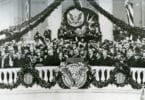Early Life and Background
James Buchanan was born on April 23, 1791, in Cove Gap, Pennsylvania. He was the second of eleven children born to James Buchanan Sr., a successful merchant and farmer, and Elizabeth Speer Buchanan. Raised in a well-off family, Buchanan received a good education. He attended Old Stone Academy before enrolling at Dickinson College in Carlisle, Pennsylvania. Despite facing disciplinary issues, he graduated in 1809.
Buchanan studied law under James Hopkins in Lancaster, Pennsylvania, and was admitted to the bar in 1812. He quickly established a successful legal practice and became involved in local politics.
Early Political Career
Buchanan’s political career began in the Pennsylvania House of Representatives, where he served from 1814 to 1816. He then moved on to national politics, winning a seat in the U.S. House of Representatives in 1820. Buchanan served five terms in the House, where he became known for his support of states’ rights and his alignment with the Democratic-Republican Party.
In 1831, President Andrew Jackson appointed Buchanan as the U.S. Minister to Russia. Buchanan’s diplomatic skills were on display as he successfully negotiated the first commercial treaty between the United States and Russia. Upon his return, he was elected to the U.S. Senate, where he served from 1834 to 1845. During his time in the Senate, Buchanan continued to champion states’ rights and supported the expansion of U.S. territory.
Rise to National Prominence
Buchanan’s prominence in national politics continued to grow. He served as Secretary of State under President James K. Polk from 1845 to 1849, playing a key role in the negotiations that led to the Oregon Treaty with Great Britain and the Treaty of Guadalupe Hidalgo with Mexico, which ended the Mexican-American War and expanded U.S. territory.
After his term as Secretary of State, Buchanan sought the Democratic nomination for president in 1852 but was defeated by Franklin Pierce. Buchanan was then appointed as the U.S. Minister to the United Kingdom, where he served from 1853 to 1856. His time in London further bolstered his reputation, and he was seen as a strong candidate for the presidency upon his return.
Presidency (1857-1861)
Election and Inauguration
In 1856, Buchanan was nominated as the Democratic candidate for president, running against Republican John C. Frémont and former President Millard Fillmore, who ran as the candidate of the American Party. Buchanan’s platform of popular sovereignty, which allowed territories to decide on the issue of slavery themselves, appealed to many voters. He won the election and was inaugurated as the fifteenth President of the United States on March 4, 1857.
Domestic Policy and the Issue of Slavery
Buchanan’s presidency was dominated by the issue of slavery and the increasing tensions between the North and South. He believed that the issue of slavery should be settled by the Supreme Court and supported the controversial Dred Scott decision of 1857, which ruled that African Americans were not citizens and that Congress had no authority to prohibit slavery in the territories. This decision further inflamed sectional tensions and deepened the national divide.
The Panic of 1857
Another significant challenge of Buchanan’s presidency was the Panic of 1857, a financial crisis triggered by the collapse of the Ohio Life Insurance and Trust Company. The panic led to widespread economic distress, bank failures, and high unemployment. Buchanan’s response to the crisis was limited, as he believed in a laissez-faire approach to the economy and opposed federal intervention.
Bleeding Kansas and Sectional Conflict
The conflict in Kansas over whether it would enter the Union as a free or slave state continued to escalate during Buchanan’s presidency. His support for the pro-slavery Lecompton Constitution, which was rejected by anti-slavery settlers in Kansas, further polarized the nation. Buchanan’s inability to resolve the Kansas issue peacefully contributed to the rising tensions that would eventually lead to the Civil War.
Personal Life and Character
James Buchanan is the only U.S. president who never married. His fiancée, Anne Caroline Coleman, broke off their engagement and died shortly thereafter, leading to speculation and rumors about Buchanan’s personal life. Buchanan remained a lifelong bachelor, and his niece, Harriet Lane, acted as the White House hostess during his presidency.
Buchanan was known for his diplomatic skills and extensive political experience, but his indecisiveness and failure to address the nation’s growing sectional crisis marred his presidency. He believed in preserving the Union through compromise, yet his actions often failed to satisfy either side of the slavery debate.
Interesting Aspects of Buchanan’s Presidency
The Dred Scott Decision
One of the most consequential events during Buchanan’s presidency was the Supreme Court’s Dred Scott decision. Buchanan supported the decision, hoping it would settle the issue of slavery once and for all. Instead, it intensified the national debate and pushed the country closer to civil war.
Buchanan’s Foreign Policy
Despite the domestic turmoil, Buchanan had some success in foreign policy. He sought to expand American influence in Central America and the Caribbean, including efforts to annex Cuba, although these efforts were ultimately unsuccessful. His administration also worked to improve relations with Britain and China.
Legacy and Impact
James Buchanan’s presidency is often ranked among the least effective in American history, largely due to his failure to address the nation’s deepening sectional crisis and his support for the Dred Scott decision. His inability to prevent the secession of Southern states and the onset of the Civil War has cast a long shadow over his legacy.
However, Buchanan’s extensive public service and diplomatic achievements prior to his presidency demonstrate his commitment to the nation. His efforts in expanding U.S. territory and managing international relations are notable aspects of his career.
Post-Presidency
After leaving office in 1861, Buchanan retired to his home, Wheatland, in Lancaster, Pennsylvania. He wrote a memoir, “Mr. Buchanan’s Administration on the Eve of the Rebellion,” defending his presidency and actions. Buchanan lived to see the end of the Civil War, passing away on June 1, 1868.
Conclusion
James Buchanan’s life and presidency provide a complex portrait of a leader who faced one of the most challenging periods in American history. From his extensive political career to his troubled presidency, Buchanan’s story is a reflection of the nation’s struggles with sectional tensions and the issue of slavery.
While his presidency is often criticized for its failures and controversies, Buchanan’s contributions to U.S. diplomacy and his efforts to maintain the Union are significant. His tenure remains a pivotal chapter in American history, highlighting the deep divisions and challenges that ultimately led to the Civil War.
Here are five highly recommended books about James Buchanan:
James Buchanan by Jean H. Baker
Part of The American Presidents Series, this concise biography by Jean H. Baker provides a balanced and insightful look at Buchanan’s life, presidency, and the challenges he faced. It’s an accessible read that covers the key aspects of his tenure.
President James Buchanan: A Biography by Philip S. Klein
This comprehensive biography by Philip S. Klein offers a detailed account of Buchanan’s life, from his early years and political career to his presidency and legacy. Klein provides a thorough analysis of Buchanan’s actions and decisions.
James Buchanan and the Coming of the Civil War edited by John W. Quist and Michael J. Birkner
This collection of essays, edited by John W. Quist and Michael J. Birkner, examines Buchanan’s presidency and the events leading up to the Civil War. The book provides multiple perspectives on Buchanan’s leadership and the era’s complex issues.
Mr. Buchanan’s Administration on the Eve of the Rebellion by James Buchanan
This memoir, Written by Buchanan, offers his perspective on his presidency and the tumultuous events leading up to the Civil War. It’s an essential primary source for understanding Buchanan’s views and justifications for his actions.
The Worst President–The Story of James Buchanan by Garry Boulard
Garry Boulard’s book critically examines Buchanan’s presidency and argues why he is often considered one of the worst U.S. presidents. The book provides a detailed analysis of his failures and the lasting impact of his decisions.






